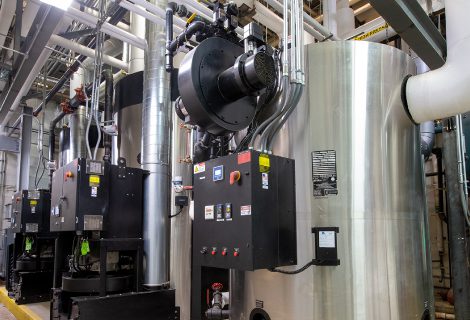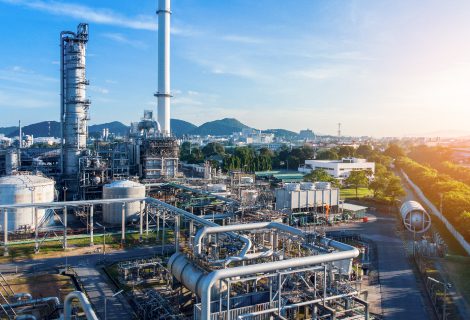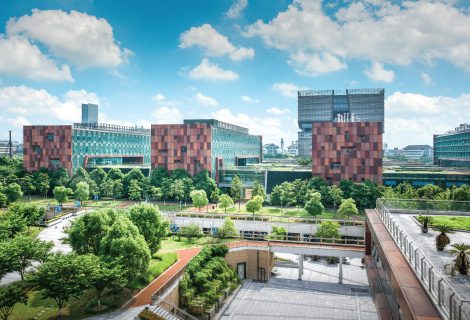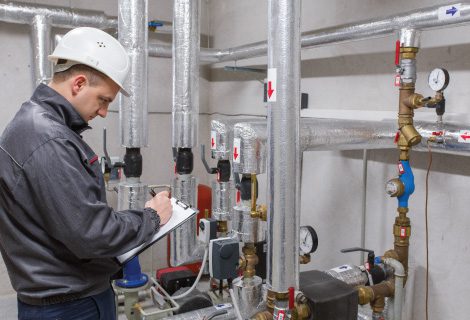How Do Combined Heat & Power Systems Work?
Heat is almost always a by-product of creating electricity. CHPs use a power station or heat engine to create electricity while harnessing heat simultaneously. The combined heat and power system then provides a portion of the electrical load needed by the facility by capturing the heat from exhaust gases. This thermal energy or heat can then be utilized for a range of different purposes, such as:
- Hot water needs
- Process heating
- Cooling
- Space heating
- Dehumidification
In the days of yore, it was extremely commonplace for hotels, large offices, and apartment buildings to create their own power and waste steam for building heat. Today, CHPs are primarily used in large manufacturing factories and facilities along with energy efficient building controls.
Which Applications Are Ideal for Combined Heat & Power Systems?
The most suitable applications for combined heat and power systems or cogeneration are those with consistent thermal and electric loads. Common examples of these facilities include:
- Industrial facilities
- Hospitals
- Hotels
- Recreational facilities
- Schools
- Nursing homes
- And more
In either case, cogeneration systems are heavily concentrated in areas with:
- High commercial and industrial activity,
- Policies that are favorable to CHP, and
- High electricity rates.
Combined Heat & Power Advantages & Benefits
Combined heat and power systems boast a vast number of benefits compared to thermal energy production and conventional electricity. Some of these benefits include:
- Efficiency Benefits — CHP systems require much less fuel to deliver a specific output of energy as well as avoids distribution and transmission losses. In addition, many CHP systems can operate on a range of fuels including natural gas, biogas, pellets, and other types of fuel.
- Security Benefits — CHP systems allow you to supplement large energy demands or completely operate off the grid, which offers excellent energy security. In short, unreliable electricity present a serious, quantifiable health, safety, and business risk for organizations. CHP systems are an on-site generation resource that can support continued operations in the event of a grid disruption or disaster.
- Environmental Benefits — Less fuel is required to produce energy and because distribution losses and transmission losses are avoided, CHP systems reduce greenhouse gas emissions as well as other pollutants.
- Financial Benefits — CHP systems reduce energy costs and can deliver savings of up to 40%, while offering a permanent reduction in energy costs. This doesn’t include any potential tax credits and savings your facility may earn.
- Legal Benefits — If you’re building a new facility, CHP systems can help the facility meet emerging legislation.
Disadvantages of Combined Heat & Power Systems
While there are several advantages to combined heat and power systems, some of the disadvantages include:
- Financially Intensive — The initial start-up costs for installing a combined heat and power system can be relatively high. This fact can make CHPs an especially difficult solution for smaller scale businesses, facilities, or operations.
- Not Suitable for All Companies — CHP systems are primarily used for companies that have both hot water and heating needs at relatively consistently high and sustained levels.
Is a Combined Heat & Power System Right for My Facility?
- How would you know if your facility is a good candidate for a CHP? If you answer “yes” to any of the following questions, your facility may be a good candidate to discuss CHPs further with the experts at ATI of New York.
- Are you concerned about the impact of future or current energy costs on your business bottom line?
- Is your business situated in a deregulated electricity market?
- Does your facility function for over 5,000 hours a year?
- Do you have concerns about the reliability of your electricity supply? Would you suffer substantial health, safety, or business impacts if the supply of electricity was interrupted?
- Do you have hot water, steam, hot air, or chilled water thermal loads throughout the year?
- Are you expecting to upgrade, replace, or retrofit boilers within the next three to five years?
- Have you already taken steps to improve energy efficiency with no success?
- Are you looking forward to a new construction project or a facility expansion within the next five years?
- Do you have concerns about limiting the carbon footprint of your facility?
Contact ATI of New York to Combined Heat & Power Advantages and Disadvantages
When comes to comparing combined heat and power advantages and disadvantages, every facility is different. Even so, there are a significant number of indirect and direct financial savings that CHP systems provide. Fortunately, the experts at ATI of New York can help.
We are the authorized manufacturer’s representative for 2G Energy — a leader in combined heat and power or cogeneration technology. Our experienced team of CHP experts can conduct a customized needs analysis to best understand your needs and guide you to the best solution.










